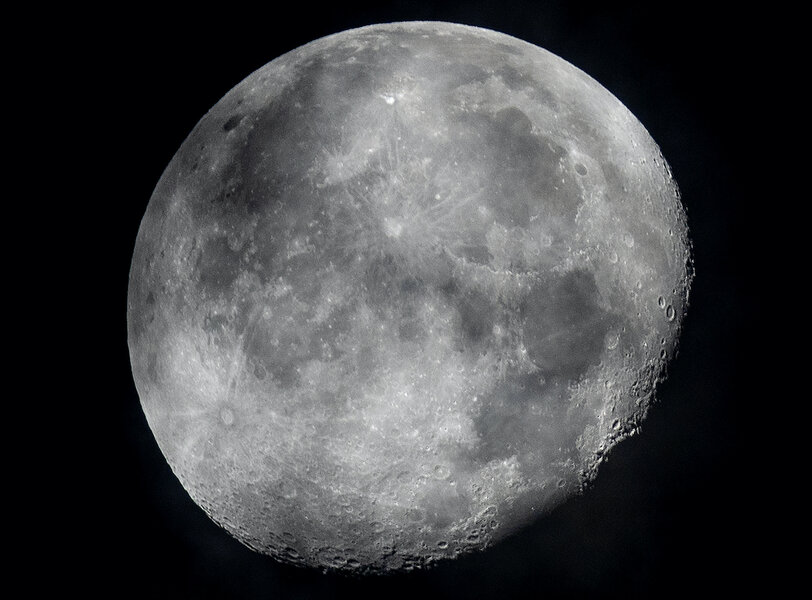Evidence of water on the moon opens new frontiers
| Cape Canaveral, FL
The moon’s shadowed, frigid nooks and crannies may hold frozen water in more places and in larger quantities than previously suspected. And for the first time, the presence of water on the moon’s sunlit surface has been confirmed, scientists reported Monday.
That’s good news for astronauts at future lunar bases who could tap into these resources for drinking and making rocket fuel.
While previous observations have indicated millions of tons of ice in the permanently shadowed craters of the moon’s poles, a pair of studies in the journal Nature Astronomy take the availability of lunar surface water to a new level.
More than 15,400 square miles of lunar terrain have the capability to trap water in the form of ice, according to a team led by the University of Colorado’s Paul Hayne. That’s 20% more area than previous estimates, he said.
The presence of water in sunlit surfaces had been previously suggested, but not confirmed. The molecules are so far apart that they are in neither liquid nor solid form, said lead researcher Casey Honniball, a postdoctoral fellow at NASA’s Goddard Space Flight Center in Maryland.
“To be clear, this is not puddles of water,” she stressed at a news conference.
NASA’s astrophysics director Paul Hertz said it’s too soon to know whether this water – found in and around the southern hemisphere’s sunlit Clavius Crater – would be accessible. The surface could be harder there, ruining wheels and drills.
These latest findings, nonetheless, expand the possible landing spots for robots and astronauts alike – “opening up real estate previously considered ‘off limits’ for being bone dry,” Dr. Hayne said in an email to The Associated Press.
For now, NASA said it still aims to send astronauts to the lunar south pole, especially rich in frozen water. The White House deadline is 2024.
As for the shadowed areas believed to be brimming with frozen water near the moon’s north and south poles, temperatures are so low that they could hold onto the water for millions or even billions of years. These so-called cold traps get down to minus 261 degrees Fahrenheit.
Using data from NASA’s Lunar Reconnaissance Orbiter, the researchers identified cold traps as small as a few yards across and as wide as 18 miles and more, and used computer models to get all the way down to micrometers in size.
“Since the little ones are too small to see from orbit, despite being vastly more numerous, we can’t yet identify ice inside them,” Dr. Hayne said. “Once we’re on the surface, we will do that experiment.”
For the second study, scientists used NASA’s airborne infrared observatory Sofia to conclusively identify water molecules on sunlit portions of the moon just outside the polar regions. Most of these molecules are likely stored in the voids between moon dust and other particles or entombed in the glassy residue of of micrometeorite impacts. In this way, the molecules can withstand the moon’s harsh environment, scientists said.
By flying 45,000 feet above Earth, the Sofia plane is above the water vapors that can interfere with infrared observations.
For now, Sofia can analyze only the moon’s outermost surface, but these water molecules could be buried yards deep, Dr. Honniball noted. As a comparison, the Sahara desert has 100 times the amount of water than what Sofia detected in the lunar soil.
Scientists believe all this water on the moon came from comets, asteroids, interplanetary dust, the solar wind, or even lunar volcanic eruptions. They’ll have a better idea of the sources “if we can get down on the surface and analyze samples of the ice,” Dr. Hayne said.
Jason Bleacher, chief scientist for NASA’s human exploration and operations office, said at some point decisions will need to be made regarding lunar technology. Will it be easier to survive the extremely cold polar environments and tap into deep shadowed craters for water, he asked, or to dig into the moon at the milder middle latitudes in search of water.
“I can certainly envision ways that robots might be beneficial in all of those,” Dr. Bleacher said.
NASA plans to launch a water-seeking rover named Viper to the moon’s south pole by the end of 2022. Astronauts would follow in a series of missions intended to set up long-term bases. The space agency wants its new Artemis moon-landing program to be sustainable, unlike the Apollo program a half-century ago.
This story was reported by The Associated Press.





